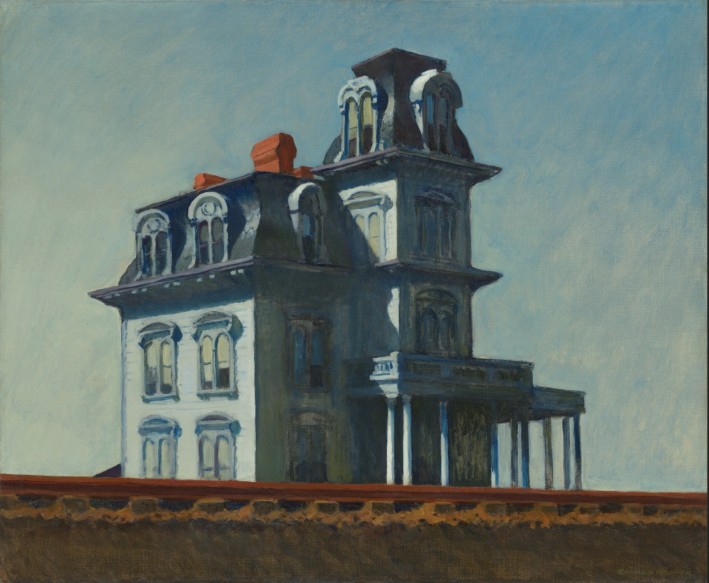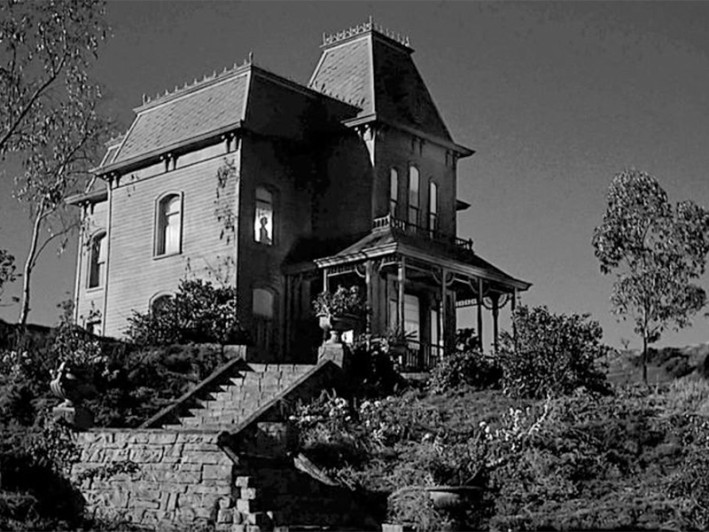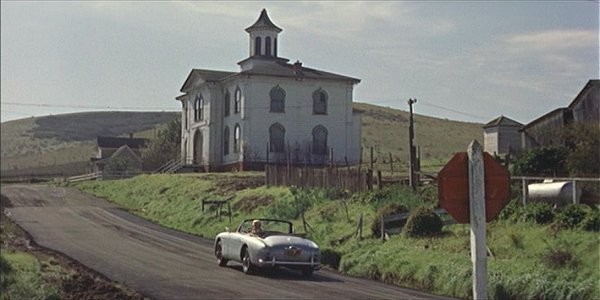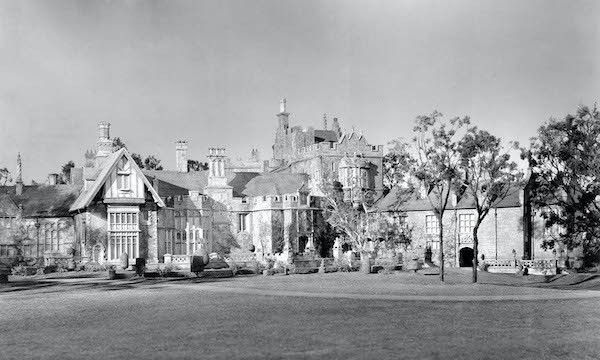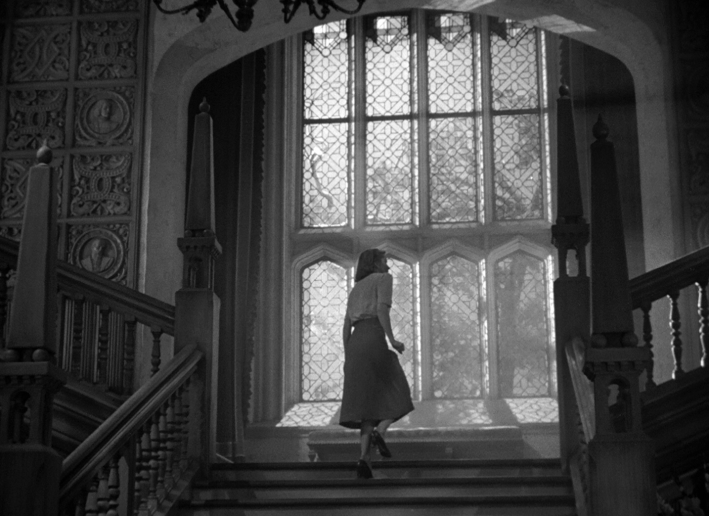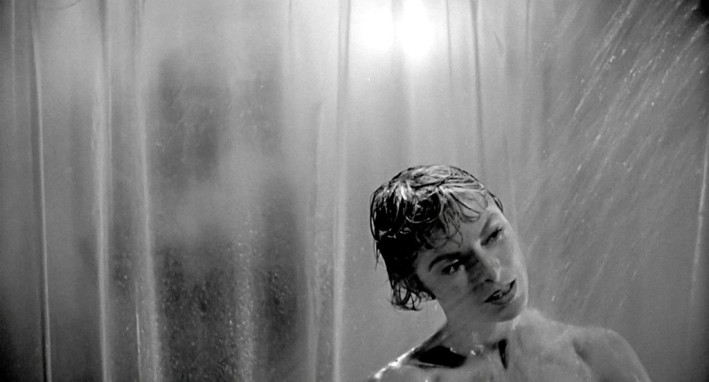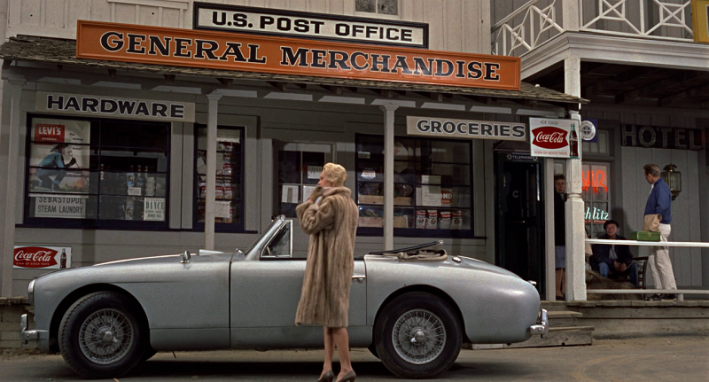Hitchcock's Menacing Houses by Alicia Byrnes
It has simultaneously figured as a site of refuge from a horrible virus, and a space of confinement (with my partner, from the outside world). My present circumstance made me especially attentive to the shared strategy of these films to source horror in the negation of secure boundaries: in Psycho, the threat resides within Marion’s hotel room (and not the haunted house on the hill, as many scholars of the horror genre have noted); in The Birds, the threat penetrates from without, finding an opening within the home’s structural framework (the chimney); and in Rebecca, the threat is a liminal presence that one can never eradicate (as “I” [Joan Fontaine] tells us, even after Manderley has burned down she still returns there in her dreams). This collection of films demonstrates Hitchcock’s prime interest in architecture as a set of boundaries to be transgressed.
Each of these films draw some degree of inspiration for their architecture from Edward Hopper’s 1925 painting, “House by the Railroad”. Hopper’s works tend to convey a sense of ‘loneliness, estrangement, stillness, and mystery’.[1] This particular painting conjures such feelings through its depiction of an isolated High Victorian Gothic house set under a clear blue country sky. The house is multi-storied, with a small tier at its peak that could serve as a lookout. Each story features large windows that inhibit a look inside, making the residence appear empty. Light illuminates the left side of the house, while the front is cast in hard shadows that ‘obscure the entryway, veiling and erasing the door’.[2] The painting’s most curious feature is thought to be the set of a railway tracks that sit at its foreground, concealing the foundations of the house. The railway tracks—an emblem of modernity—jar In toto, these features (the railway tracks, the shadows, the absence of people) give Hopper’s house an air of unknowability that was surely appealing for Hitchcock. with the period architecture of the house to trouble the viewer’s sense of time.
To be clear, Hitchcock has not to my knowledge identified “House by the Railroad” as a touchstone for the architecture in these three films. Numerous scholars have, however, noted the striking resemblance between Hopper’s house and the Bates home in Psycho, and I would argue that the schoolhouse in The Birds and the Gothic mansion of Manderley in Rebecca also bear a kind of resemblance.[3] The similarities between these structures would seem to connote an affective link. That is to say, perhaps Hitchcock’s visual allusion to Hopper signals his shared sense of unease about sites of supposed safety, like the schoolhouse or the home. Indeed, that the threats present in Rebecca, Psycho and The Birds find some way of circumventing material boundaries indicates that Hitchcock sees these structures as less stable or secure than we might like to believe. With these films, the director shows that the various divisions articulated by architecture—inside and outside, civil and uncivil, control and disorder, safety and danger, and so forth—are more ideological than actual. Architecture serves as a means for Hitchcock to confront the anxieties underpinning such divisions.
One of Hitchcock’s collaborators, the production designer Robert F. Boyle,[4] claims that the director did appreciate Hopper’s work, specifically his depiction of the ‘penultimate moment’.[5] ‘The penultimate moment’, Boyle explains, ‘is the moment before something actually happens… Somebody like Hitchcock would tell you that the Hopper look is the look of the penultimate moment’.[6] The penultimate moment of “House by the Railroad” surely pertains to the appearance of a train on the tracks in the image’s foreground, intimating a journey from city to country, or vice versa. The collection of Hitchcock films under examination here invoke this same moment. Each of these films begins with a passage from the city to the country that anticipates the imminent transgression of architectural boundaries. Rebecca starts in the south of France, where “I” meets Maxim DeWinter (Laurence Olivier) while holidaying with her employer. “I” and Maxim quickly become engaged and journey back to his home in the seaside Cornwall. In Psycho, Marion Crane (Janet Leigh) leaves Phoenix on a whim for the imaginary town of Fairvale. Alas, she never makes it; Marion’s journey ends abruptly at the decentred Bates Motel. The Birds begins with Melanie Daniels’ (Tippi Hedren) passage from San Francisco to Bodega Bay, where she wilfully delivers a pair of love birds to Mitch Brenner’s (Rod Taylor) family home in a bid to seduce him. In each case, the woman’s centripetal movement seems to trigger the intrusion of a threat into secure space.
Noted horror scholar Carol J. Clover identifies the passage from the city to the country as a hallmark of the horror genre. She writes that ‘an enormous proportion’ of horror films begin in this way, the idea being ‘that rural Connecticut (or wherever)… is a place where the rules of civilization do not obtain’.[7] Horror thus finds purchase in the vulnerability of ‘city people’ to the non-customs of the country.[8] The move from city to country forms the centrepiece of some horror films (see, for instance, Deliverance [John Boorman, 1972]), but in this
collection of Hitchcock films serves as the first sign of the heroine’s undoing. Once arrived in the country, these women find themselves in spaces akin to what Clover has termed ‘The Terrible Place’.[9] The Terrible Place is ‘most often a house or tunnel’ that ‘may at first seem a safe haven, but the same walls that promise to keep the killer out quickly become, once the killer penetrates them, the walls that hold the victim in’.[10] (And I regretfully note here the eerie similarity between this description and my earlier account of the lockdown home.) The concept of The Terrible Place chimes with the characterisation of Hitchcock’s architecture developed thus far: Rebecca, Psycho and The Birds canvas a series of uncanny sites that, through structural fault or haunting, cultivate danger. To be sure, Clover credits the Bates mansion in Psycho as the preeminent Terrible Place, and the Brenner home in The Birds as a later example.[11] Equally apt is the Gothic mansion of Manderley in Rebecca.
Manderley demonstrates Hitchcock’s desire to negate secure boundaries through its unknowability. For one, the parameters of the house are slippery. In Manderley’s debut scene (we get a glimpse of it in Rebecca’s prologue, but it is fire-damaged and obscured by moonlight), we learn that the house sits some way from the property’s entrance. In fact, the stretch of tree-flanked, gravel road that Maxim and “I” drive to reach Manderley is so long that they encounter inclement weather on the way; just before the house appears on screen for the first time, it begins to rain. After a close-up shot of “I”’s awestruck expression, a panning long-shot introduces Manderley. The house is so monstrous that it dwarfs the couple’s car at the foot of the frame, and actually exceeds the camera’s view. Irrespective of Hitchcock’s choice of shot length, Manderley cannot be captured in a single frame. Adding to its mysteriousness, the house does not in fact exist as it appears in the diegetic world. Manderley was built as an oversized miniature for the film (for scale, the door of the model was about thirty-centimetres tall), thus making its size in this debut scene even harder to contemplate.
This introduction to Manderley foretells “I”’s inability to negotiate its interior. The heroine’s dislocation here stems from her naiveté, which is a key feature of the film’s narrative. A significant age gap exists between she and Maxim (Olivier was only thirty-two at the time of shooting, ten years Fontaine’s senior), and he routinely comments on her youthfulness. At the beginning of their courtship, for instance, he tells her, ‘Please promise me never… to be thirty-six years old’. The Oedipal nature of the couple’s relationship is underscored by her status as an orphan without a name. When Maxim proposes to “I” he effectively adopts her, giving her both a home and his family name. In terms of physical appearance, “I” is plain and petite. In sum, she is homely, which ironically renders her out of place in Manderley.
Like its architecture, Manderley’s décor is oversized: doors, windows, tables, chairs, candelabras, portraits, flower arrangements are all exaggerated to a scale that would seem designed to antagonise “I”. What is more, the house comes with a set of customs that require her daily supervision: she must advise the gardener, confirm the dinner menu, answer correspondence. “I”’s failure to take charge of such tasks renders her experience of
living at Manderley distinctly anxious. And of course, the house’s gargantuan size poses a threat to her, too. “I” discovers new parts of the property, such as the cottage near the beach, or the West Wing, after living there for days. Importantly, both of these sealed-off spaces are associated with Maxim’s late wife, Rebecca. The cottage near the beach is where her tryst with Jack Favell took place, as well as her death. The West Wing houses her private room (she and Maxim clearly did not share a bed), which Mrs Danvers (Judith Anders) has preserved like a museum. The association of Rebecca with specific sites on the property signals that, in this film, architecture is part and parcel of the horror. Fear for “I” stems from her struggle to assert agency in a space over which Rebecca still seems to preside. Manderley—the house itself, its objects, its customs—bears Rebecca’s presence, and thus challenges ideas about the home as a site of ownership.
Psycho poses similar questions about the value of architectural boundaries as a means of privacy or protection. The film centrally does so through a motif pertaining to concealment. Psycho starts with a passage through an open window of a random building, at a random time of day, on a random date to discover an affair. The presentation of its opening scene, which begins with a panning wide-shot over Phoenix that then tracks through the ajar window, situates Hitchcock’s camera, and by extension the viewer, as a voyeur. Through the camera’s gaze we become privy to a midday rendezvous that we are not supposed to see. (Much has been written on the meta-textual nature of such scenes in Hitchcock’s oeuvre; the director seems intent on reminding us that, as cinema viewers, we are always peering in on people who don’t know they’re being watched.) This seemingly coincidental passage through the window implicates us in Marion’s story. She and Sam (John Gavin) want to be married, but they don’t have any money. The predicament sets into motion a series of boundary crossings—moral, geographical, architectural—that result in Marion’s murder.
The randomness of Psycho’s choice of subject is important because it signals that what happens to Marion could happen to anyone. The film’s opening intertitles register the time at which we meet her: “FRIDAY, DECEMBER THE ELEVENTH” at “TWO FORTY-THREE P.M.”. That afternoon Marion steals $40,000 from her employer, sets off for Fairvale, and stops at the Bates Motel on the way due to bad weather. The sojourn at the Bates Motel is meant to be a part of the narrative, not the point, and it is therefore shocking when Marion’s story ends here. The irrationality of Marion’s death is augmented by the fact that her murder does not take place in the creepy mansion at the top of the hill—the most precise ringer for Hopper’s “House by the Railroad” of the houses surveyed here—but in the motel that fronts it. This shift in the site of horror from haunted house to innocuous motel room is thought to be Psycho’s key contribution to the horror genre. Hitchcock was likely cognisant of the significance of this shift, as testified by his introduction to the Bates property. The scene depicting Marion’s arrival elides a proper look at the Bates Motel and instead presents an image of the Bates mansion at its spookiest (at night, in the rain, a single window illuminated). The mansion is first depicted in a perfectly composed long-shot, and then a mid-shot of the illuminated upper story window as Mrs Bates-né-Norman (Anthony Perkins) passes by in a nightrobe. Hitchcock in effect encourages the viewer to behold the house on the hill with suspicion, and the motel below as an afterthought.
In some sense, we should have known that the Bates mansion was not deserving of our immediate suspicions. (I say immediate because horrible things do eventually occur there.) The motif of concealment that Hitchcock established at the film’s outset is used to characterise the Bates Motel. Norman repeatedly remarks upon the motel’s distance from the highway, at one point even conceding that it is ‘hiding from the world’. The motel, like Marion and Sam’s affair, is concealed from proper view. Thus, following the logic of that opening scene it makes sense that the Bates Motel becomes the pivotal site of transgression. The action of trespassing occurs here in a chain: there is the moment where Norman peers in on Marion getting undressed from his private office (note the similarity to our voyeuristic disposition in the opening scene); the moment, which occurs off-camera, where Norman enters Marion’s motel room using his key, dressed as his mother, brandishing a knife; and there is the moment where he enters the bathroom, the most private of private spaces. Indeed, just scenes earlier we observed that Norman cannot even say the word “bathroom”—it is an unspeakable space. It is thus telling of Hitchcock’s intentions that he stages Marion’s murder there.
Marion’s murder is undoubtedly troubling because she is the film’s protagonist. Therefore, after she disappears we are unsure with whom to identify. More deeply, her murder worries us because it is expressly quotidian. Dovetailing with the randomness of her murder is the fact that it takes place in the shower, where she is most vulnerable and thus trusting of her safety. Her death reminds us that architectural boundaries do not promise privacy or protection. In actuality, Hitchcock suggests, threat may lurk within our living quarters (just on the other side of the wall) and have a key to get in. In a prosaic revisioning of the danger present in Rebecca, Psycho presents the threat as internal. The film’s quotidian brand of horror is perhaps nowhere better articulated than in the D.I.Y. clean-up of Marion’s murder: in an inordinately long sequence, Norman uses water, a mop, a shower curtain and a hand towel to cover over the crime.
In The Birds, horror derives from the negation of the border between inside and outside. Like many good horror films, it refuses to provide a clear motive or metaphor for its events. Instead, Hitchcock entertains a number of possible lines of reasoning that altogether speak to the fragility of the divisions drawn by architecture. One possible cause for the bird attacks is Melanie and her scheme to seduce Mitch. The film begins in San Francisco where the seagulls are already agitated, perhaps due to an impending storm. Melanie provokes them further by traversing a set of interrelated boundaries: first she travels from the city to Bodega Bay, and once there she introduces a pair of lovebirds into domestic space. That these movements prefigure a series of increasingly savage bird attacks suggests that Melanie has destabilised some natural order. In one of Hitchcock’s more subtle gestures toward her culpability, she is swooped by a seagull just after delivering the lovebirds to the Brenner’s home. Minor as this attack may be, it marks Melanie as the instigator of the birds’ revolt. In a more damning expression of her blame, a later scene at the diner following the birds’ most spectacular attack sees Melanie implicated by the women of Bodega Bay. ‘I think you’re the cause of all this’, one mother tells her, ‘I think you’re evil’.
Hitchcock confuses that line of reasoning by also associating Melanie with the birds, such that they mirror her movements. Rather than identifying Melanie as the cause of the bird attacks, this method of interpretation situates the two in a metaphorical relationship: Melanie is an unruly woman whose intrusion into the space of the home is reflected by the birds. Indeed, Melanie’s arrival in Bodega Bay is treated with as much suspicion as one might summon upon finding a bird indoors. A local woman eyes Melanie as she steps out of her sportscar before the hardware store wearing a lush fur coat. Inside, the store clerk is equally unsure about her. Moreover, Melanie’s entry into domestic space is just as wilful as the birds’. She is so intent on surprising Mitch that she hires a motorboat to stage her delivery, slipping in and out of the Brenner home uninvited. Equally telling of Melanie’s kinship with the birds is the fact that she first stays at the Brenner home on the evening that a swarm of sparrows get in through the chimney. Irrespective of Mrs Brenner’s (Veronica Cartwright) misgivings about Melanie, she, like the sparrows, finds a way of infiltrating the household.
Beyond these possibilities to do with Melanie, the bird attacks may be a consequence of the larger colonisation of the natural world by humanity, as Mrs Bundy (Ethel Griffies) argues at the diner. Or they may be due to bad weather at sea, as Mrs MacGruder (Ruth McDevitt) suggests at the film’s opening. Hitchcock’s reluctance to prioritise a single line of reasoning conveys his sense that such events are not susceptible to logic. Any one of these interpretations is plausible, he suggests, and by flagging each of them he encourages us to accept our non-understanding. That Hitchcock makes this point through the birds, specifically their violation of the boundary between inside and outside, speaks to the centrality of architecture to his horror. Seemingly secure spaces, and the divisions that they articulate (here not only inside and outside, but also humanity and nature, order and chaos), become a way of getting at our underlying insecurities. The depiction of the attack at the schoolhouse is apposite. Mrs Brenner worries that the building is liable to threat due to its number of large windows (much like Hopper’s house). When Melanie arrives at the schoolhouse and notices a flock of crows quietly assembling on the climbing frame outside, she and Annie Hayworth (Suzanne Pleshette) attempt a stealthy evacuation through the front doors. Ultimately, the crows sense the children’s movements and attack anyway. This failed attempt to outsmart the birds proves that architectural boundaries cannot be read as a means for protection.
In the collection of films examined here, Hitchcock transgresses architectural limits to remind us what they represent. In Rebecca, Manderley figures to expose “I”’s personal insecurities concerning her homeliness and inability to assert herself. Architecture in Psycho and The Birds serves to uncover more existential anxieties. Through Marion’s murder at the Bates Motel, Psycho challenges our want to believe that evil is distant or recognisable. The bird attacks in The Birds undermine our sense of agency over our surroundings, specifically our natural surroundings. In sum, these films use architecture to confront the boundaries that make us feel safe.
Written by Dr. Alicia Byrnes
Alicia Byrnes is a PhD candidate and teaching associate in Screen Studies at the University of Melbourne. She holds an MA in Cinema Studies from New York University. Her doctoral research negotiates the disappearance of the female body from contemporary science fiction cinema through an examination of digital materiality. Her work has appeared in the journals Deletion and Science Fiction Film and Television, and a forthcoming book on forgotten film noir texts. Her research interests include feminist film theory, materialist cinema studies, and film aesthetics.
[1] “Edward Hopper. House by the Railroad. 1925,” The Museum of Modern Art, accessed October 19, 2020, https://www.moma.org/collection/works/78330.
[2] Sarah Burns, “‘Better for Haunts’: Victorian Houses and the Modern Imagination,” American Art 26, no. 3 (Fall 2012): 6.
[3] In fact, the list architectural allusions to Hopper’s house in Hitchcock’s oeuvre does not end here: see also the courtroom in The Paradine Case (1947) and the church in Vertigo (1958).
[4] Boyle worked on four of Hitchcock’s films, including The Birds.
[5] The Criterion Channel, “Hitchcock, Hopper, and the Penultimate Moment,” video, https://www.criterion.com/current/posts/5966-hitchcock-hopper-and-the-penultimate-moment.
[6] Ibid.
[7] Carol J. Clover, Men, Women, and Chain Saws: Gender in the Modern Horror Film, 2nd ed. (Princeton and Oxford: Princeton University Press, 2015), 124.
[8] Ibid, 128.
[9] Ibid, 30.
[10] Ibid.
[11] Ibid, 30-31.
